
Bois d'ArcBOH-dark is an unincorporated community in Butler County, Kansas, United States. It is located about six miles southeast of Augusta in Bloomington Township.

The Mahned Bridge was constructed in 1903 and spans the Leaf River in Perry County, Mississippi. Around 1980, the bridge was removed from service and access was terminated. The bridge was declared a Mississippi Landmark in 1996 and was added to the National Register of Historic Places in 1997.
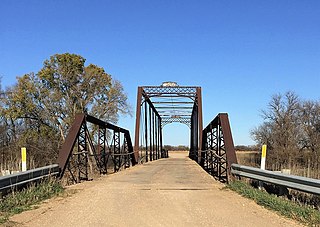
Pott's Ford Bridge is a bridge 1/2 mile south of Glasco, Kansas, USA that spans the Solomon River in Cloud County, Kansas. It has a wooden deck with three bowstring pony trusses and one Pratt pony truss. The lengths of the trusses are 48 feet (15 m), 46 feet (14 m), and 149 feet (45 m) for the bowstring trusses, and 72 feet (22 m) for the Pratt truss. It was built in 1884 by the Wrought Iron Bridge Company of Canton, Ohio.
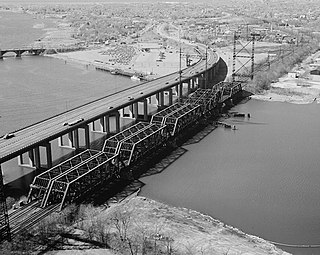
The Housatonic River Railroad Bridge is a historic bridge carrying Metro-North Railroad's New Haven Line trackage across the lower Housatonic River in the U.S. state of Connecticut. The bridge is also used by Amtrak for its Northeast Corridor services. It was listed on the National Register of Historic Places in 1987, which also refers to the bridge as the Devon Bridge. It is also referred to as the Devon Railroad Bridge by the state Department of Environmental Protection.
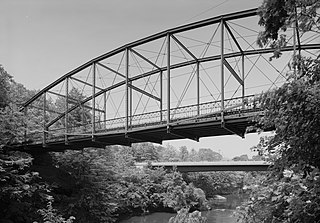
The Lover's Leap Bridge is a wrought-iron lenticular truss bridge over the Housatonic River located in Lovers Leap State Park in New Milford, Connecticut. Built in 1895 by the Berlin Iron Bridge Company, it is one of the last bridges built by the company and is a particularly ornate example of its work. It was listed on the National Register of Historic Places in 1976 and is now open only for foot traffic.

The Lilley Road—Lower Rouge River Bridge is an automotive bridge located on Lilley Road over the Lower River Rouge in Canton, Michigan. It was listed on the National Register of Historic Places in 2000.

The Jackson Branch Bridge No. 15, also known as the Tecumseh Railroad Bridge due to its close proximity to the city of Tecumseh, is a historic railway deck truss bridge that spans the River Raisin in rural Raisin Charter Township in Lenawee County, Michigan. The bridge was added to the National Register of Historic Places on December 4, 2001.

Cartersville Bridge is a historic bridge located near Cartersville, Cumberland County, Virginia. The original bridge was constructed in 1822, and its five stone piers of rough cut ashlar and rubble and two stone abutments remain. Atop them is a superstructure constructed in 1883-84 of heavy timber members with cast-iron connections arranged to form a truss configuration based on the Pratt truss. The bridge is composed of six spans with an end-to-end length of 843 feet (257 m).

The bridge is significant locally as the only Pratt through-truss bridge remaining in Kosciusko County, and is important regionally as one of the few surviving spans built by the Bellefontaine Bridge and Iron Company.

The California Powder Works Bridge is a historic covered bridge in Santa Cruz, California. It is a Smith truss bridge, built across the San Lorenzo River in 1872 by the California Powder Works, an explosives manufacturer whose factory complex stood on the river banks. The bridge was designated a National Historic Landmark in 2015 as one of the best-preserved national examples of the Smith truss. It is owned and maintained by the Paradise Park Masonic Club, and is open to pedestrian and vehicular traffic, with a posted weight limit of 5 tons.
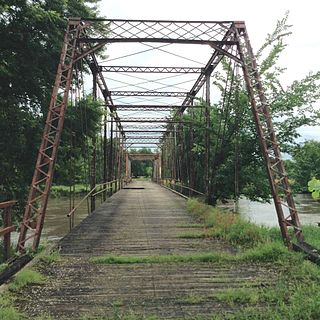
The Chambers Ford Bridge is located southeast of Chelsea, Iowa, United States. It spans the Iowa River for 345 feet (105 m). The Tama County Board of Supervisors approved a petition to construct a bridge at Chambers Ford under the condition that the local residents to secure the right-of-way for the bridge, build the trestle work and all approaches to the bridge. The Clinton Bridge and Iron Works of Clinton, Iowa built a single-span, pin-connected Pratt truss in 1890. By the turn of the 20th century the north end of the timber trestle approach that the local citizens constructed deteriorated beyond repair. The county contracted with the George King Bridge Company of Des Moines for $3,987 to build a new Pratt through truss. It was listed on the National Register of Historic Places in 1998. The bridge has been closed since 2007

The Bridgewater Corners Bridge carries Vermont Route 100A across the Ottauquechee River in the Bridgewater Corners village of Bridgewater, Vermont. It was built in 1928 by the American Bridge Company, following devastating flooding. It is a single-span Pratt through truss structure, and was listed on the National Register of Historic Places in 1992.

The Iron Bridge at Howard Hill Road is a modern pony truss bridge, carrying Howard Hill Road across the Black River in southeastern Cavendish, Vermont. It is a replacement for an historic 1890 Pratt through truss bridge, which is now in storage. The historic bridge was listed on the National Register of Historic Places in 1982.

The Lincoln Covered Bridge is a historic covered bridge, just south of U.S. Route 4 in West Woodstock, Vermont. Built in 1877, it is one of the only known examples of a wooden Pratt truss bridge in the United States. It was listed on the National Register of Historic Places in 1973.

The Oakland Mills Bridge is a historic structure located in Oakland Mills Park southwest of Mount Pleasant, Iowa, United States. The span carried Hickory Road over the Skunk River for 358 feet (109 m). In July 1876 the Henry County Board of Supervisors decided to locate the bridge over the Skunk River at Oakland Mills. After engineers looked over the proposals, they choose the Missouri Valley Bridge and Iron Company of Leavenworth, Kansas to build the structure. The long-span combination Pratt truss through and pony truss was completed later the same year. The steel components where manufactured by the Phoenix Iron Company of Pennsylvania. It is one of the oldest Pratt through truss bridges in Iowa. Long closed to vehicular traffic, it was listed on the National Register of Historic Places in 1998.

The New Hampton Pony Pratt Truss Bridge is a historic pony Pratt truss bridge on Shoddy Mill Road in New Hampton of Lebanon Township, Hunterdon County, New Jersey. It crosses the Musconetcong River between Lebanon Township, Hunterdon County and Washington Township, Warren County. It was designed by Francis C. Lowthorp and built in 1868 by William Cowin of Lambertville, New Jersey. The bridge was added to the National Register of Historic Places on July 26, 1977 for its significance in engineering, industry and transportation. It is one of the few early examples of iron Pratt truss bridges remaining in the United States. It was later documented by the Historic American Engineering Record in 1991. It was added as a contributing property to the New Hampton Historic District on April 6, 1998.
The Morseville Bridge is a bridge which formerly carried Burt Road over the Flint River in Taymouth Township, Michigan. It was listed on the National Register of Historic Places in 1990. It is the oldest surviving highway bridge in Saginaw County.

The Gugel Bridge, also known as the Beyer Road – Cass River Bridge, is a bridge carrying Beyer Road over the Cass River in Frankenmuth Township, Michigan. It was listed on the National Register of Historic Places in 2000. It is the only remaining example in Michigan of a bridge with both a pony truss span and a main through truss span.

The Glen Gardner Pony Pratt Truss Bridge is a historic pony Pratt truss bridge on School Street crossing the Spruce Run in Glen Gardner of Hunterdon County, New Jersey. It was designed by Francis C. Lowthorp and built in 1870 by William Cowin of Lambertville, New Jersey. The bridge was added to the National Register of Historic Places on September 22, 1977 for its significance in engineering, industry and transportation. It is one of the few early examples of iron Pratt truss bridges remaining in the United States. It was later documented by the Historic American Engineering Record in 1991.
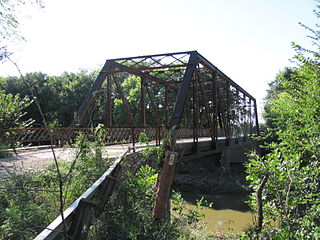
The Cottonwood River Pratt Truss Bridge is a historic bridge which carries Main Street across the Cottonwood River in Cedar Point, Kansas, USA. The single-span Pratt truss bridge was built in 1916 by the Missouri Valley Bridge and Iron Company. Locals proposed a bridge along a western extension of Main Street in 1914, but construction did not begin until late 1915 due to negotiations over its price; the county initially received no bids for the bridge after underestimating its cost, and it rejected every bid in the second round until the Missouri Valley Company dropped theirs to $8,750. The bridge is 142 feet (43 m) long, 17 feet (5.2 m) wide and is 32.5 feet (9.9 m) above the river. The Pratt truss design, with vertical and center-facing diagonal beams, was commonly used at the time due to its stability. The Cottonwood River bridge is one of roughly 800 examples of the type in Kansas.






















